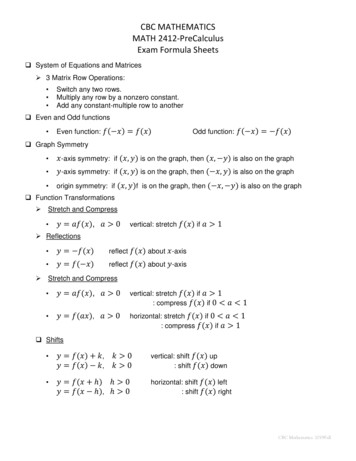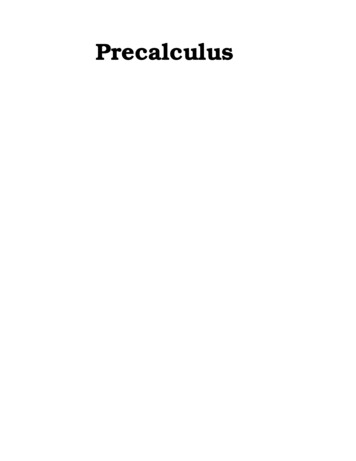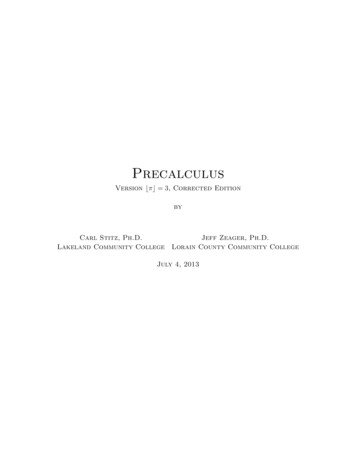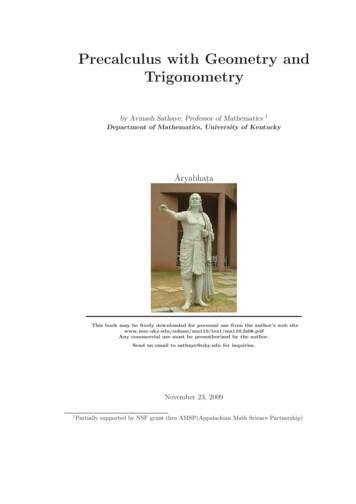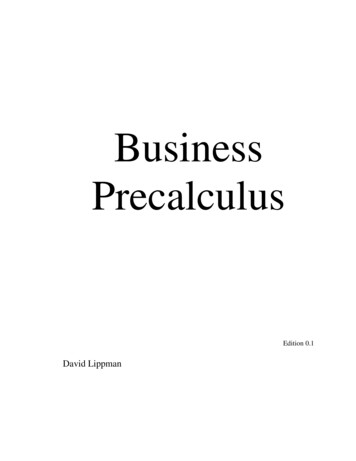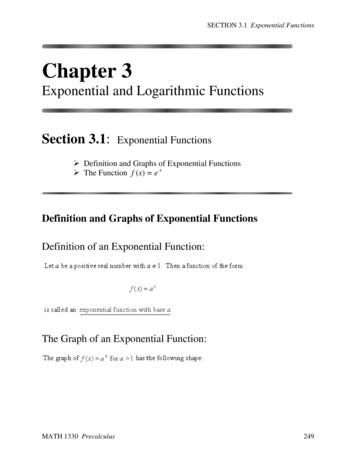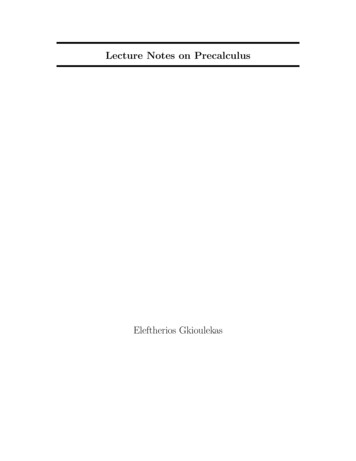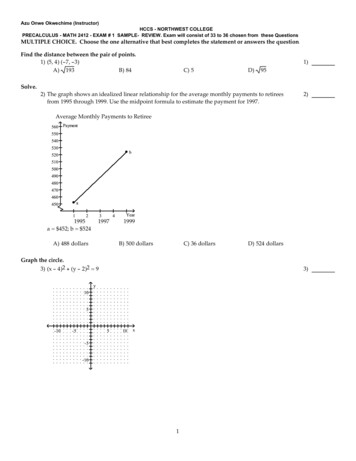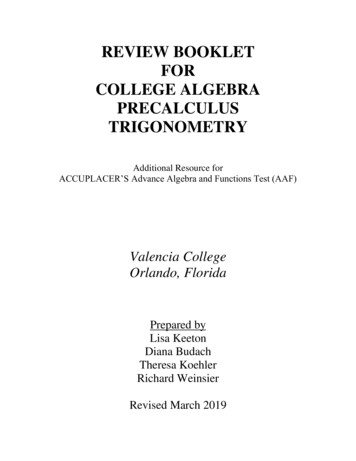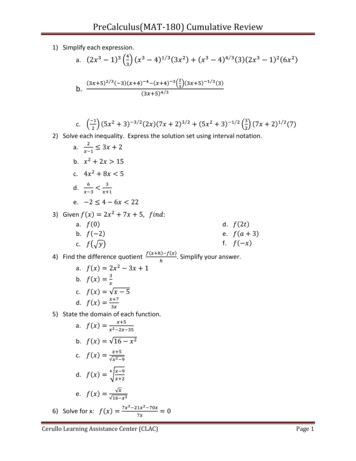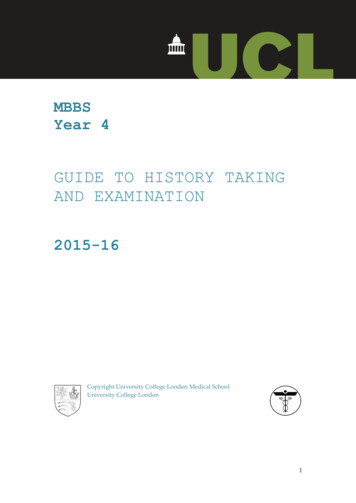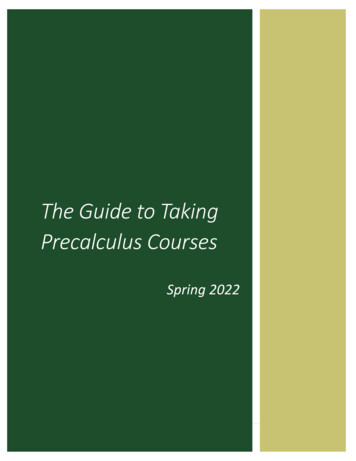
Transcription
The Guide to TakingPrecalculus CoursesSpring 2022Page 0
PhilosophyThis Guide is intended for students who are taking pre-calculus mathematics courses in Colorado StateUniversity’s Precalculus Program.Entry-level mathematics courses intended to prepare students to take other university courses that usemathematics are called pre-calculus courses. These courses include College Algebra, Logarithmic andExponential Functions, and Trigonometry. At Colorado State, all pre-calculus courses are taught in thePrecalculus Program.Students who take pre-calculus mathematics are an academically diverse group. They have differentbackgrounds, aptitudes, attitudes, and goals. In the early 1970's the CSU Mathematics Department becameconvinced that these students were not well served in traditional classrooms where, in spite of thesedifferences, everyone is expected to learn in similar ways and at similar rates. This led to the development ofthe Precalculus Program.Since its inception, the management and development of the Precalculus Program has been guided by thebeliefs that college students must take the responsibility and initiative for their own learning and that givensuitable learning resources, adequate time, and sufficient positive encouragement all college students canmaster entry level mathematics. The instructional design of these courses is based on a mastery program,meaning that students will achieve a minimum level of proficiently with each topic before proceeding to thenext.In the past forty-six years, the Precalculus Program has developed into a flexible instructional system thatgives all CSU students the opportunity to master pre-calculus mathematics by providing them choices ofcontent, an array of learning resources, variability in credits and deadlines, and various levels of individualsupport and encouragement. In 1996 the university recognized the quality of the Individualized MathematicsProgram (the former name of the Precalculus Program) by awarding Dr. Klopfenstein, one of its long-timedirectors, the N. Preston Davis Award for Instructional Innovation.The next evolution of the Precalculus Program was launched Fall Semester of 2005 with fully onlineinstructional material and the ability for students to work on their Precalculus courses nearly 24x7. TheCollege of Natural Sciences awarded Dr. Paul Kennedy, a former director of the Precalculus Program, the2007 Excellence in Teaching Award for Teaching Innovation in recognition of the design and developmentof this online instructional platform. In 2008, Dr. Kennedy was honored by being selected as a UniversityDistinguished Teaching Scholar.This Guide provides students in the Precalculus Program with the information they need to organize andmanage their learning experiences.Page 1
ContentsGeneral Information. 4Location .4Hours .4Precalculus Professional Staff.4Contact Information .4COVID-19 Information . 5Precalculus Courses . 6Weekly Expectations and Due Dates . 7Learning Resources in the Precalculus Program . 7e-text .7Video Lectures .7Learning Center .7Solutions .8Resource Desk .8Supplemental Websites.8Course Procedures and Organization . 9User’s Exam .9Skills Review .9Learning Objectives .9Required Assignments .9Review Exams .9Unit Exams . 10Final Exam. 10Reviewing Previous Exams . 10Retesting . 10Course Completion . 11Testing . 11Mechanics of Taking an Exam in the Testing Center . 11Grading . 11Disabilities. 12Academic Misconduct . 13Appendix I: Sample User’s Exam . 14Appendix II: Exam Dues Dates, Enrollment in One or Two Courses, Spring 2022 . 18Page 2
Appendix III: Exam Dues Dates, Enrollment in Three or More Courses, Spring 2022 . 19Appendix IV: Registration Deadline Dates, Spring 2022 . 21001 Sections. 21801 and 809 Sections . 21Appendix V: Helpful Tips to Studying Math . 22Appendix VI: Precalculus Program Quick Start Guide . 23Page 3
General InformationLocationThe Precalculus Center is located on the first floor in the Weber Building.Inside the Precalculus Center:Learning CenterResource DeskOfficeTesting CenterWeber 136Weber 136Weber 137Weber 138HoursThe Precalculus Center is open from January 18th – May 6th.Day hoursMonday-Friday9:00am-4:00pmEvening hoursMonday-Thursday6:30pm-9:00pmThe Precalculus center will be closed March 14th – 18th.The Precalculus website is active 24x7* from January 18th – May 6th.*A maintenance window is reserved from 6:00am - 9:00am daily. If you use the system during thistime, you do so at your own risk. The system may be taken offline without warning during this windowto perform system maintenance.Precalculus Professional StaffProf. Steve Benoit, Co-Director (He, His, Him)Ms. Anita Pattison, Associate Director (She, Hers, Her)Contact InformationPrecalculus Director: 137 Weber BuildingE-mail: precalc math@colostate.eduPhone: (970) 491-5761To comply with Federal privacy laws, we cannot give out personal information over the phone.You must either: meet with a director and bring your RamCard, or send an email from your CSU email including your full name and CSU ID number.Page 4
COVID-19 InformationImportant information for students:Masks are required inside university buildings. You must also meet university vaccine orexemption requirements.All students are expected and required to report to the COVID Reporter(https://covid.colostate.edu/reporter/) when: You suspect you have symptoms of COVID, regardless of whether or not you are vaccinated andeven if your symptoms are mildYou have tested positive for COVID through a non-CSU testing site, such as home test or test ata pharmacyYou believe you may have been exposed to COVID go to the COVID Reporter and follow theguidance under “I believe I have been in close contact with someone who has COVID-19.” Thisguidance will depend upon your individual circumstancesYou will not be penalized in any way for reporting symptoms or concerns.Do not ask us as your instructors to report for you. It is your responsibility to report through theCOVID Reporter promptly.As your instructor we may not ask you about vaccination status or if you have COVID but youmay freely volunteer to send me information from a public health official if you have been askedto isolate or quarantine.When you complete the COVID Reporter, the CSU Public Health office is notified. Once notified, thatoffice will contact you and, depending upon each situation, will conduct contact tracing, initiate anynecessary public health requirements and notify you if you need to take any steps.If you do not have internet access to fill out the online COVID-19 Reporter, please call (970) 491-4600.For the latest information about the University’s COVID resources and information, including FAQsabout the spring semester, please visit the CSU COVID-19 site https://covid.colostate.edu/.Page 5
Precalculus CoursesEach course is one-credit. Below are the course prerequisites for each of the five courses as well aslinks to the PDFs of the appropriate formal course syllabi (including gtPathways-specific information)and the course outlines and objectives.MATH 117: College Algebra in Context I,Prerequisite: (1)Course syllabusCourse outline and objectivesMATH 118: College Algebra in Context II,Prerequisite: MATH 117 or (2)Course syllabusCourse outline and objectivesMATH 124: Logarithmic and Exponential Functions,Prerequisite: MATH 118 or (2)Course syllabusCourse outline and objectivesMATH 125: Numerical Trigonometry,Prerequisite: MATH 118 or (2)Course syllabusCourse outline and objectivesFigure 1 Course Prerequisite StructureMATH 126: Analytic Trigonometry,Prerequisite: MATH 125 or (2)Course syllabusCourse outline and objectives(1) To register for MATH 117, you must satisfy one of the following: earn an appropriate score on the Colorado State University Math Placement Tool or the ELM(Entry Level Mathematics) Exam. complete MATH 055, MATH 093, or MAT 099, with a C- or higher at a Colorado CommunityCollege.(2) To register for MATH 118 or higher, you must satisfy one of the following: an appropriate placement on the Math Placement Tool. satisfactorily completing the prerequisite course(s) at Colorado State. transfer credit for course(s) from another college or university.You may take as many as five courses in a semester as long as the prerequisite for each course issatisfied or included in the package for which you are registering. Use RAMweb to register forPrecalculus courses. You must register for all Precalculus courses you plan to take during the semesterPage 6
by the add deadline. The add, drop, and withdrawal period deadlines for the Precalculus courses aregiven in Appendix IV.Notice that being allowed to register for a course does not imply that you are eligible to take the course.If you are unable to access the online course materials because of a prerequisite problem, come to thePrecalculus Office where the staff will work with you to determine whether and how you satisfied thecourse prerequisite.Weekly Expectations and Due DatesThe University expects students to be spending approximately three hours per week per credit on theircourses (page 2 of the “Advising and Registration” section of the General Catalog). You have theflexibility to arrange which hours each week you want to schedule to complete your math.All students are responsible for completing the required coursework on time. Use the table in AppendixII or III to find the due dates for your coursework based on the number of Precalculus courses in whichyou are registered. To recover from missed due dates, you may reduce the number of Precalculuscourses in which you are enrolled to get a new set of due dates and potentially recover lost points.Speak with a Precalculus Program Director if you have any questions or concerns.Learning Resources in the Precalculus ProgramBelow is a list of resources available to help you succeed in the Precalculus Program.e-text Contains the course objectives for each unit and provides printable PDF files of lecture notes.You will have automatic access to the e-text without purchasing a physical copy or access codefrom the CSU Bookstore. Once the drop date passes (see Appendix IV), the CSU Bookstore willcharge your account the cost of the e-text.The e-text grants access to all registered Precalculus courses for that semester. Followingsemesters will require additional purchases; however, you will retain access to the e-text for anycourses you complete.Video Lectures Lectures present a single objective at a time.Can be viewed multiple times and can be paused to allow you to take notes.“Try This” problems: You should try to solve these problems on your own and then check yoursolution by watching the video solution.Learning Center Staffed with undergraduate course assistants trained to help you learn the Precalculus contentwho provide walk-in tutoring 45 hours a week!The most current information about the on-campus and the virtual Learning Center will beposted via the “Getting Help” link.Page 7
Do not expect a course assistant to just give you answers, they will expect you to have done yourpart by studying the online materials and making a serious effort to understand and solveproblems.Solutions For every exam taken, you will be able to review the exam and see a solution to each problem.Access each exam taken via the links located at the end of each unit.Keep organized scratch work when you take an exam. It is helpful for you to have your scratchwork as you review the exam solutions and when you have a need to discuss a problem with acourse assistant.Resource DeskCalculators Texas Instruments TI-83 or TI-84 Graphing Calculators are needed for all Precalculuscourses. Able to be checked out from the Precalculus Resource Desk with your RamCard. These calculators may ONLY be used in the Precalculus Center. Calculator manuals maybe checked out for daily use. Texas Instruments offers a free 90 day trail of their TI-84 emulating mputer r-software-for-the-ti-84-plus-family/tabs/overview Texas Instruments also maintains a listing of TI-83/84 tutorial pport/training online tutorials/graphing-calculatorsTextbooks May be checked out for a two-week period with your RamCard.Laptops or iPads Laptop computers and iPads can be borrowed to be used ONLY in the Precalculus Center.Headphones May be checked to be used ONLY in the Precalculus Center with your RamCard.Longboards/Skateboards/Scooters Can be stored at the Resource desk.Padlocks May be checked out for daily use to secure your belongings in a locker when you need to take aproctored exam.Supplemental Websites Khan Academy is a free resource. It may require you to set up an account.Purple Math has many lessons for free. However, Purple Math Plus requires you to enroll inmonthly or yearly plan.S.O.S. Mathematics is a free resource.West Texas A & M University Virtual Math Lab is a free online tutorial.Page 8
Course Procedures and OrganizationUser’s ExamThe user’s exam tests students about policies, procedures, and the instructional resources of thePrecalculus program. This guide contains all the information needed.SettingNumber ofQuestionsMinimumScore to PassNumber ofAttemptsUnproctored2016UnlimitedPassingUnlocks Skills ReviewExamSkills ReviewThe skills review exam contains basic mathematical skills necessary for successful completion of thecourse. After the first attempt, videos to help you brush up on your mathematical skills are unlocked.SettingNumber ofQuestionsMinimumScore to PassNumber ofAttemptsUnproctored108UnlimitedPassingUnlocks LearningObjective 1.1Learning ObjectivesEach unit has five learning objectives. There is an overview video to introduce the topic being studied.The sub-objectives have many example videos to help gain a fuller understanding of the topic. You canattempt the “Try This” problems on your own, then look at the video for a solution. At the end of thelearning material for the objective, you will find the link to the Required Assignment.Required AssignmentsThere is a required assignment for each learning objective. These assignments help solidify yourknowledge of the content from the video lectures. You can complete these assignments multiple timesfor extra practice.SettingNumber ofQuestionsMinimumScore to PassNumber ofAttemptsUnproctored33UnlimitedPassingUnlocks Next LearningObjectiveReview ExamsThere are four review exams per course. To gain access, you must have completed the requiredassignment for that unit AND passed the previous unit’s proctored exam. If the review exam iscompleted by the deadline, you will earn 3 points; else, you will earn no points (see Grading on page11). A good way to study for the final is by retaking the review exams.SettingNumber ofQuestionsMinimumScore to PassNumber ofAttemptsUnproctored108UnlimitedPage 9PassingUnlocks Current UnitExam
Unit ExamsThere are four unit exams per course. You are eligible to take the unit exam once the review exam forthat unit is passed. You can take the unit exam an unlimited number of times; however, every two timesyou do not pass you must repass that unit’s review exam. Once the unit exam is passed, you can take itan unlimited number of times until the due date for the final exam. If you have passed the final exam,you may retest until the last day of classes for the current semester. Only your best passing score willcount toward your grade (see Grading on page 11).SettingProctored(40 minutetime limit)Number ofQuestions10MinimumScore to Pass8Number ofAttempts2 non-passingattempts at atime, unlimitedonce you passPassingUnlocks Next Unit’sReview Exam orthe Final ExamFinal ExamThe final exam is cumulative and is only unlocked after the unit 4 exam is passed. You have unlimitedattempts to take the final exam until the end of testing on the due date. If you have passed the unit 4exam but have not passed the final by the date it is due, you will be allowed one* attempt the nextbusiness day.SettingProctored(75 minutetime limit)Number ofQuestions20MinimumScore to Pass16Number ofAttemptsUnlimitedPassingUnlocks Next Precalculuscourse (if youhave at least 54points in thecourse, retest asneeded)Reviewing Previous ExamsAt any time, if you wish to review the exams you have taken during the semester, click the exam linklocated in the applicable section. the sidebar.RetestingThere are no restrictions on the number of times you may take an exam. Regardless of how many timesyou take an exam, only your best passing score will count toward your final grade.You may retest in any previously passed unit of any course until the due date for the Final Exam for thatcourse. If you have passed the Final Exam, you may continue retesting until the last day of classes forthe current semester. You may need to retest to earn enough points to complete the course and/or youmay wish to retest to improve your grade.If you are taking several courses, you may retake exams from an earlier course even though you havegone on to another course. For example, if you finished your first course but only earned a "C" grade,Page 10
you may proceed to another course and at the same time continue to work on the first one to earn ahigher grade.Course CompletionIn addition to passing the four unit exams and the final exam with a score of at least an 80% on eachexam, you must earn 54 points or higher to complete the course (see Grading on page 11).TestingStudents enrolled in CSU Online courses (sections 401, 801, and 809) will access their proctored examsvia the “quizzes” tab in Canvas. In order to maintain academic integrity, students must make sure theonline video of the testing session is recording the testing session correctly. Students will need to showtheir photo ID when requested. They will also need to scan their testing environment. This videoshould include a 360-degree pan of the room, including the desktop surface and the walls. The webcamshould remain focused on the student during the testing session and the webcam should not be covered.Failure to follow these guidelines may result in an academic misconduct report and a grading penalty.Online students may also test on campus in the Precalculus Testing Center.On-campus students (sections 001 – 005) will test in the Precalculus Testing Center (Weber 138).The Testing Center has the same walk-in hours as the Precalculus Center (see General Information onpage 4) with the following notes: Testing Center doors close 15 minutes before closing time, and no new exams may be started. All exams MUST be submitted by closing time.Mechanics of Taking an Exam in the Testing Center1. Bring your RamCard and a pen or pencil to Testing. All other items must be stored in aPrecalculus locker. Note: a calculator and scratch paper is provided. Writing on the hand, cell phones, and other personal electronic devices will be viewed asreference material, which is prohibited in Testing2. A staff member will assign you to a computer and give you scratch paper3. Place your RamCard (with your picture facing up) at the computer. Enter your CSU ID numberto begin the exam.4. Acknowledge the CSU Honor Pledge. Your exam and a calculator will show up on screen.5. The computer will display how much time you have left. Your exam will automatically submitonce time runs out.6. Once finished, take your belongings, and check out with a Precalculus staff member. Be sure tokeep your scratch work!7. Check your results via the Precalculus Website and use your scratch paper to go over missedproblems with a course assistant.If at any point you need assistance, raise your hand and a proctor will come help you.GradingThere are 72 total points possible in each course. The final grade is determined by the sum of your bestscores for each of the four Unit Exams and the Final Exam, plus any points earned from passing thePage 11
Review Exams by the applicable due date. The table below shows the breakdown of how you can earnpoints:Exam TypeReview ExamUnit ExamsFinal ExamNumber of Exams Points Possible forEach Exam441Total Number ofPoints Possible0 or 38 to 1016 to 200 to 1232 to 4016 to 20You can find a breakdown of the points you have earned in the class at the top of the webpage for yourcourse. Please note that no grades will be recorded in Canvas.When you have completed your courses, MATH 117, MATH 118, MATH 124, MATH 125, or MATH126, by passing all four Unit Exams, in order, and the Final Exam with best scores of 80% or better, youare assigned a grade of A, B, C, or U, according to the following table:Total Points65 to 7262 to 6454 to 61Not completed ( 54)GradeABCUIf you have not completed a Precalculus course for which you are registered, you are assigned a grade ofU (unsatisfactory). The U grade is a permanent transcript entry but does not affect the CSU grade pointaverage. However, some universities and financial aid agencies treat the U grade as an F whenevaluating student records for graduate or transfer admissions or for awarding financial aid. To earncredit for a course in which a U grade was assigned, you would need to register for the course again andsatisfactorily complete it from the beginning.A grade of F is assigned in special circumstances involving academic misconduct.An I (incomplete) may be assigned if you have worked responsibly and consistently on a course duringthe semester, but circumstances that were beyond your control and could not have reasonably beenanticipated prevented completion of the course. If you believe you qualify for an incomplete on thisbasis you should discuss your situation with a Director in the Precalculus Office.Questions and appeals concerning grades should first be directed to one of the Precalculus Directors inthe Precalculus Office (Weber 137) or send an email from your CSU email account toPrecalc math@colostate.edu. Be sure to include your CSU ID number. If differences cannot besatisfactorily resolved with a Precalculus Director, further appeals may be pursued in accordance withthe policies on Grading and Grade Appeals under “Advising and Registration” in the General Catalog.DisabilitiesColorado State University is committed to providing reasonable accommodations for all persons withdisabilities. Students with disabilities who need accommodations must first contact the StudentDisability Center before requesting accommodations for their Precalculus course(s). The StudentDisability Center is located in room 121 of the TILT Building. Their phone is (970) 491-6385Page 12
(V/TDD). Students who need accommodations must speak with a Precalculus Director in a timelymanner to discuss needed accommodations.Academic MisconductAcademic misconduct undermines the educational experience at Colorado State University, lowersmorale by engendering a skeptical attitude about the quality of education, and negatively affects therelationship between students and faculty/instructors.Faculty/Instructors are expected to use reasonably practical means of preventing and detectingacademic misconduct. Any student found responsible for having engaged in academic misconduct willbe subject to academic penalty and/or University disciplinary action.Students are encouraged to positively impact the academic integrity culture of the University byreporting incidents of academic misconduct. (See the General Catalog.)Possession of visually, audibly, or tactilely accessible materials in the Precalculus Testing Center orduring an online proctored that could assist the student in earning a higher score on an examination andattempting to misrepresent information are examples of academic misconduct.The University Policy on Academic Integrity is vigorously enforced in the Precalculus Program.Students judged to have engaged in academic misconduct may be assigned a reduced grade or a grade ofF for the course and/or other penalties may be imposed. All incidents of academic misconduct will bereported to Student Resolution Center for possible further disciplinary action. Incidents ofimpersonation may be referred to the University Police for criminal investigation.Any evidence that a student is engaging or has engaged in an act of academic misconduct will bereported to a Director of the Precalculus Program. The Director will give the student involved theopportunity to provide his/her explanation of the incident. If the student admits to engaging in academicmisconduct or if the Director judges that a preponderance of evidence exists to support the allegation ofacademic misconduct, the Director may impose an academic penalty and will report the incident toConflict Resolution and Student Conduct Service.If the student disputes the allegation of academic misconduct, he/she should request a hearing with theStudent Resolution Center. The University Hearing Officer will determine whether a preponderance ofevidence exists in support of the allegation of academic misconduct. If the University Hearing Officerfinds insufficient evidence or clears the student of charges, the penalty imposed by the PrecalculusDirector will be rescinded and the student’s previous status in the Precalculus Program restored. If theUniversity Hearing Officer finds the studen
Students who take pre-calculus mathematics are an academically diverse group. They have different backgrounds, aptitudes, attitudes, and goals. In the early 1970's the CSU Mathematics Department became . Contains the course objectives for each unit and provid
